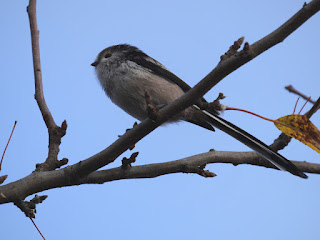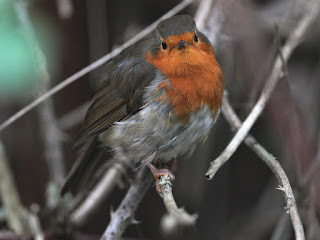There was just one Mistle Thrush on Buck Hill. I think it's a permanent resident and the autumn migrants still haven't arrived.
There were two Goldfinches, which are oddly rare in the park although there are plenty in the streets around ...
... and a flock of Long-Tailed Tits, of which there are plenty.
Also on Buck Hill was a Great Spotted Woodpecker. I got a very distant view of it before it flew away.
Ahmet Amerikali managed to see one of the elusive Cetti's Warblers beside the Long Water and was able to snatch a quick shot of it.
A Robin looked out from a bush.
The Grey Wagtail was in the Italian Garden again.
A pair of Magpies amused themselves by beating up some Feral Pigeons.
A Carrion Crow ate a pigeon at the leaf yard which had clearly been killed by a Sparrowhawk, as the scattered feathers show. Pigeons mass at the leaf yard, as do crows, because of the food left by the wretched parakeet feeders, so it's a place where Sparrowhawks often kill. But they are easily frightened off their prey.
We've had videos of Starlings bathing before, but the spectacle is irresistible so here's another.
A Grey Heron kept an eye on the clock at the Lido restaurant.
The mob of Cormorants at the island have been joined by a young one, still with a whitish front.
A Greylag Goose finished washing with a vigorous flap.
There was a blond Egyptian male on his own near the Lido restaurant. I thought he was the one from the Triangle car park who had been deprived of his mate again, but Jon Ferguson tells me he's a new arrival. He was wandering around in an unsettled way.
Another male was shielding a female from him, standing in front of her with a proprietorial air. Jon says that the blond male near the Triangle is happily reunited with his mate, at least for now.
Gadwalls are quiet and well behaved ducks, and in the park they are lucky enough to have quite an even sex ratio so that most of the drakes have a mate. Pairs stay together.













It looks as if blond Egyptians are turning up in larger quantities. I wonder why they are more numerous now - perhaps the blond look makes them more appealing as mates and thus reproduce more?
ReplyDeleteThe Heron looks like a sign from an English pub!
I'm not sure, but I think the blond characteristic in Egyptian Geese is sex-linked, and fairly common among females but rare in males. I have no evidence at all that it makes either sex more attractive. Blondie has had only two broods in her life, and the blond male at the Triangle car park has been ousted from his pair.
Delete